|
IAI Kfir C2/C7
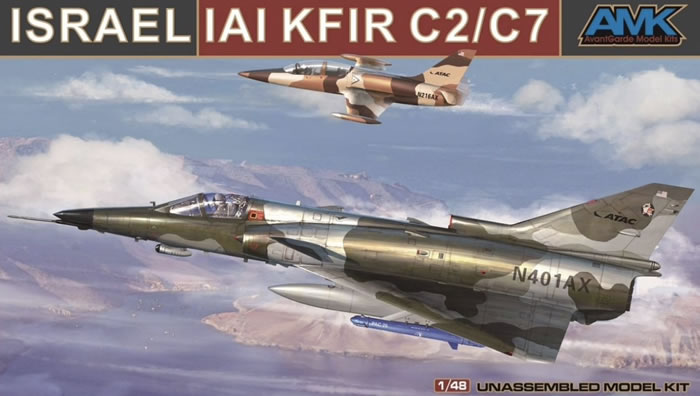
AvantGarde Model Kits, 1/48 scale
S u m m a r y : |
Catalogue Number: |
AvantGarde Model Kits Kit No. 88001-A - IAI Kfir C2/C7 |
Scale: |
1/48 |
Contents & Media: |
See text and images |
Price: |
GBP£32.99 EU Price (GBP £27.49 Export Price) plus shipping available online from Hannants |
Review Type: |
First Look |
Advantages: |
Excellent moulding; many issues corrected from original release; crisp surface textures; high level of detail. |
Disadvantages: |
None noted. |
Conclusion: |
A beautiful little project that appears to capture all the lines of this important fighter, especially with that reworked fuselage and re-tooled weapons!. |
Reviewed by
James Hatch

Kitty Hawk's 1/32 scale OS2U Kingfisher
will be available online from Squadron.com
The Israel Aircraft Industries Kfir (Hebrew: "Lion Cub") is an Israeli-built all-weather, multirole combat aircraft based on a modified French Dassault Mirage 5 airframe, with Israeli avionics and an Israeli-built version of the General Electric J79 turbojet engine.
The project that would ultimately give birth to the Kfir can be traced back to Israel's need for adapting the Dassault Mirage IIIC to the specific requirements of the Israeli Air Force.
The Kfir programme originated in the quest to develop a more capable version of the IAI Nesher, which was already in series production.
After General De Gaulle embargoed the sale of arms to Israel, the IAF feared that it might lose qualitative superiority over its adversaries in the future, which were receiving increasingly advanced Soviet aircraft. The main and most advanced type of aircraft available to the IAF was the Mirage, but a severe problem developed due to the Mirage fleet's depletion due to attrition after the Six-Day War. Domestic production would avoid the problem of the embargo completely; efforts to reverse engineer and reproduce components of the Mirage were aided by Israeli espionage efforts to obtain technical assistance and blueprints from third party Mirage operators.
The Kfir entered service with the IAF in 1975, the first units being assigned to the 101st "First Fighter" Squadron. Over the following years, several other squadrons were also equipped with the new aircraft.
The role of the Kfir as the IAF's primary air superiority asset was short-lived, as the first F-15 Eagle fighters from the United States were delivered to Israel in 1976. The Kfir's first recorded combat action took place on November 9, 1977, during an Israeli air strike on a training camp at Tel Azia, in Lebanon.
The only air victory claimed by a Kfir during its service with the IAF occurred on June 27, 1979 when a Kfir C.2 shot down a Syrian MiG-21.
Israel Aerospace Industries announced in August 2013 that it would offer pre-owned Kfir fighter jets to foreign customers, with a 40-year guarantee. Unit price is reported to be $20 million. A few Eastern European and Latin American countries have expressed interest, Israel’s Globes business daily reported.
Since the J79 turbojet engine is a U.S design, although manufactured under license in Israel, all export sales of the Kfir are subject to prior approval being granted by the U.S. State Department, a fact that has limited the sale of the Kfir to foreign nations.
As of 2006, the IAI Kfir has been exported to Colombia, Ecuador, and Sri Lanka.
Background courtesy of Wikipedia
The Kit
This isn’t the first 1/48 Kfir that AMK has released. Their first incarnation was released in 2013, but suffered from inaccuracies that related to the shape of the fuselage and the pinched ‘coke bottle’ shape that was evident when looking at the aircraft from above and three-quarters views etc. This was quite a shame when you consider the model itself was a very nice release of this important type.
In the last half of 2017, AMK released a 1/72 new-tool Kfir, so it was hardly surprising that within a short period, we would see a new, corrected release of their original Kfir. We weren’t left disappointed.
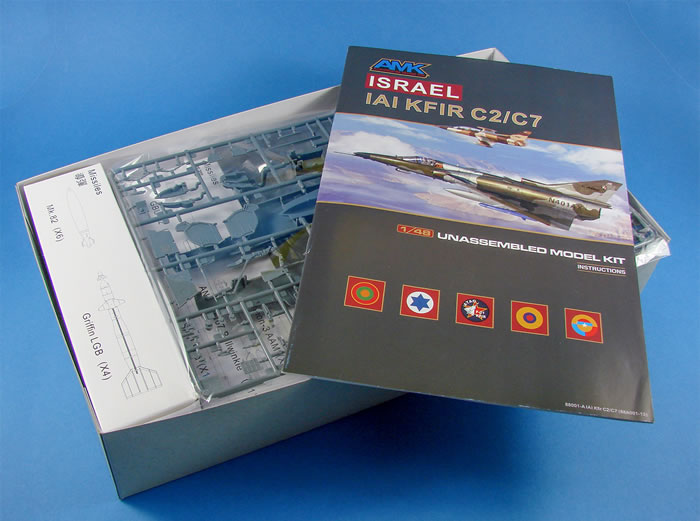
From my research, a good number of parts of the original model kit are still packaged with these release, apart from the obvious fuselage. The nomenclature of the lower wing panel is different to the original release, but one observer couldn’t detect any visible differences in shape or surface textures.
AMK also now likes to mould their weapons sets into stackable runners, and these are included, replacing the conventional and traditional style of parts in the original 2013 release.
The kit itself is packed into a box that appears small for the aircraft within, but with a very attractive box-art that focuses on an American machine instead of the typical Israeli. Images on the side of the box let us take a look at the FIVE schemes on offer with this release, and all different from the original 2013 kit.
The original AMK Kfir kit was actually their first release, and the box style is certainly a massive improvement over the original, being far more attractive, without the strange camouflage panel on the lid! Let’s take a look at the kit:
SPRUE A
This sprue simply comprises the fuselage halves, newly tooled, as already mentioned. All parts are moulded in a medium-grey styrene, with a satin finish. Having looked carefully at finished builds of the original Kfir kit, and indeed reviews of the same, the new pinched fuselage on this is quite evident and should certainly please those who criticised the original. Also very impressive of AMK to go back to that release after 4yrs and make amends with it instead of consigning it to history. The separate nose does suggest of course that other versions will follow, and they want the accuracy errors ironed out. Externally, the kit benefits from neatly recessed panel lines and panel access details. Whilst the model isn’t riveted in general, rivet/fastener detail is moulded along certain routes, such as the spine and access ports. Nicely thought out is the seam along the fin, with this darting off to coincide with a panel line on the starboard side. A moulding seam still exists on the port fin edge, but this is easily removed with a sanding sponge. Intakes, nose and RWR unit housing on the fin trailing-edge.
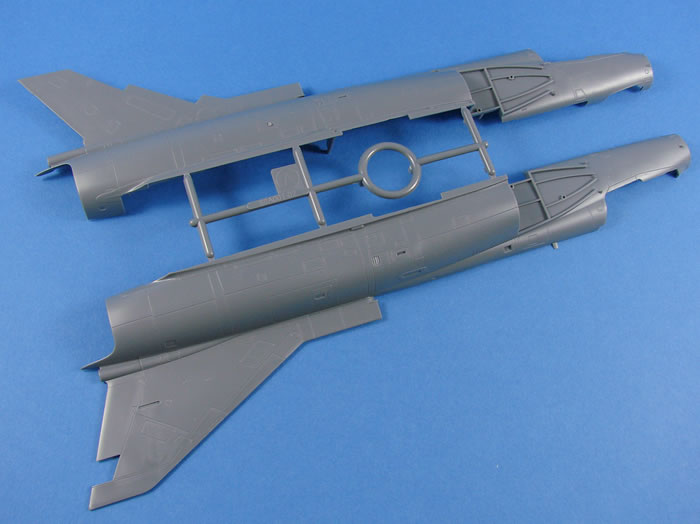
Internally, this kit now benefits from numerous strengthening features, whereas the original kit had none. Also, a mid-fuselage beam is now moulded in situ, creating just the right width at that point, instead of having to stuff your own plastic props/spacers in there. Cockpit sidewall detail is also included, albeit quite simplified. Should you wish to enhance this, and the rest of the cockpit, then Eduard have a very reasonably priced colour PE set available.
SPRUE B
Here we don’t so much as have a sprue, but just a single piece lower wing, ready to use. The original sprue gate has been removed from the open panel within the belly of the part, in the same way that Academy moulded the single piece F-4 Phantom fuselage. This will be blanked off with a large insert. Note that the ailerons are integrally moulded, with the tip wash-in (or is it washout? I can never remember.) The locating points that you can see mid-wing, are for the aileron actuators. To fit the weapons pylons, you will need to open up these points from within, although the instructions don’t actually mention this. A cursory and obvious search later in the manual will show you the various loadouts, and the pylon part numbers to fit. There is also a weapons painting/markings page with the colour schemes, and this does actually have a wing plan showing which holes to open for various loadouts. Points also exist for optional C2 bomb pylons.
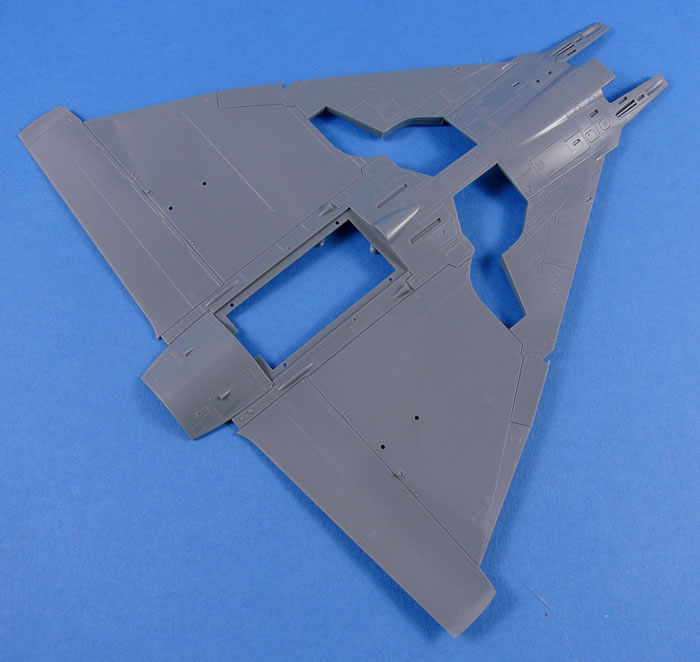
As with the fuselage fin, the upper wing panels fit with the seam running along a lower wing face panel line. I must admit that I do like this approach.
SPRUE C
From what I can gather here, there is no difference in this sprue, from the last 2013 issue. This is a general collection of parts, with items here for the cockpit, main and nose gear bays, undercarriage, gear doors, engine fan and flame holder, centreline supersonic fuel tank, centreline fuel tank and bomb pylons, etc. Those main gear bays consist of a ceiling that has three wall parts attached to it. Detail really is excellent, with perhaps only a little lead wire needed. These bay parts coincide with the fuselage location, with the remainder of the detail moulded to the inside of the upper wing panels. This same level of detail attention extends to the nose gear bay, which sits underneath the cockpit tub. Here you will see plumbing of various sizes, complete with connectors. Some careful painting and washing here will really make this go pop. Of course, it’s advisory that each panel is painted prior to assembly for this area.
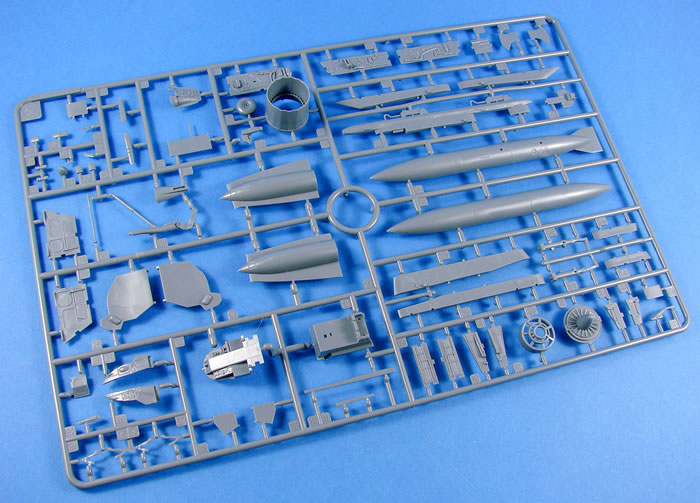
Other parts I note on this sprue are the side intake vanes, optional C2 bomb pylons, exhaust nozzle, and a two-part camera and chaff flare dispenser unit, amongst others. Of note is the instrument panel. This is specifically for the C2 version, with the C7 panel being found on the next sprue. You will also need to decide whether you want the canopy open or closed, as an optional part is included, plus a slight modification to the rear cockpit bulkhead if you wish to pose it closed.
SPRUE D
Again, I am presuming this is identical to the original kit release. The main players here are the upper wing panels with more finely engraved details and the wrap-round leading edge that joins via an underside panel line. Of note are the nose halves for the C2/C7 machines, and also the C7 instrument panel that I mentioned just above.
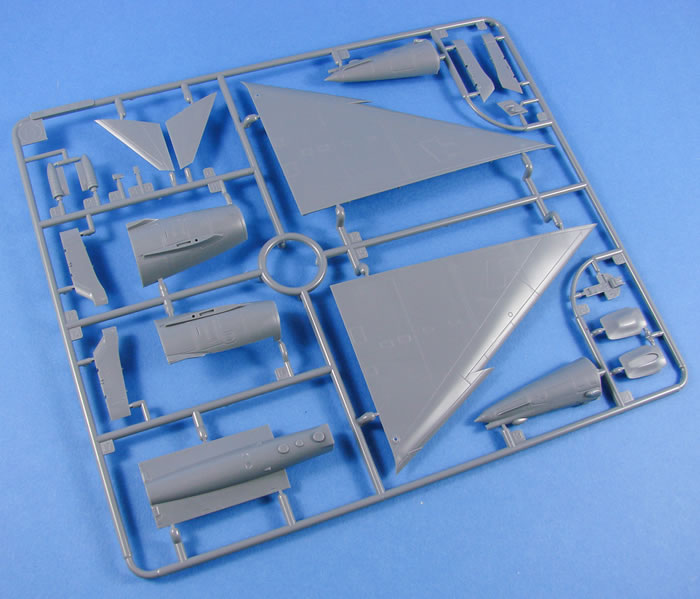
More optional parts are included in the shape of the lower cockpit underside fairings. The blanked off fairing is for the C2, whilst the bulged pertains to the C7. On the latter machine, this bulge covered the uprated avionics that were specific to this particular type.
Also here are the small canard wings, belly insert, intake fairings, Pave Penny laser designator, and stores pylons for both the TER and GBU-12 weapons.
SPRUE E (x2)
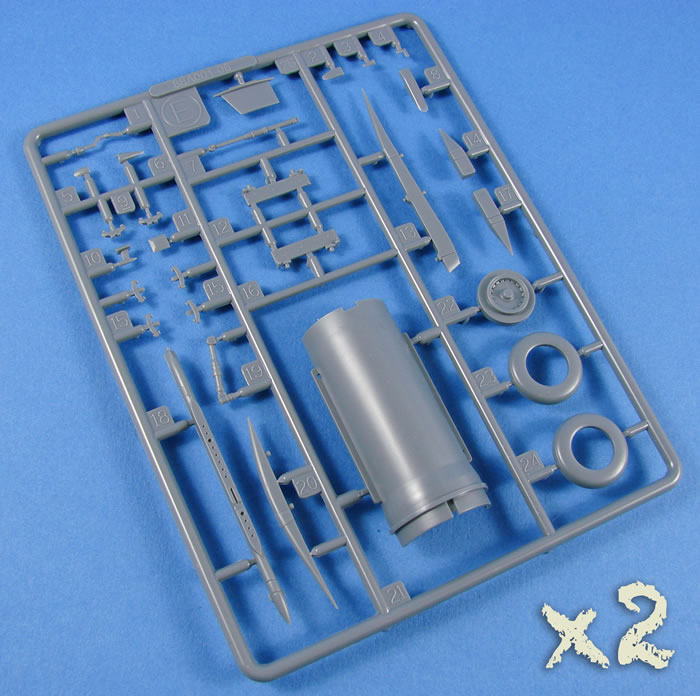
These are fairly small sprues that contain the jet tail pipe with basic internal details (some ejector pin marks too), wheels (unweighted) with separate hubs, more weapons pylons and numerous parts associated with them.
SPRUE F (x2)
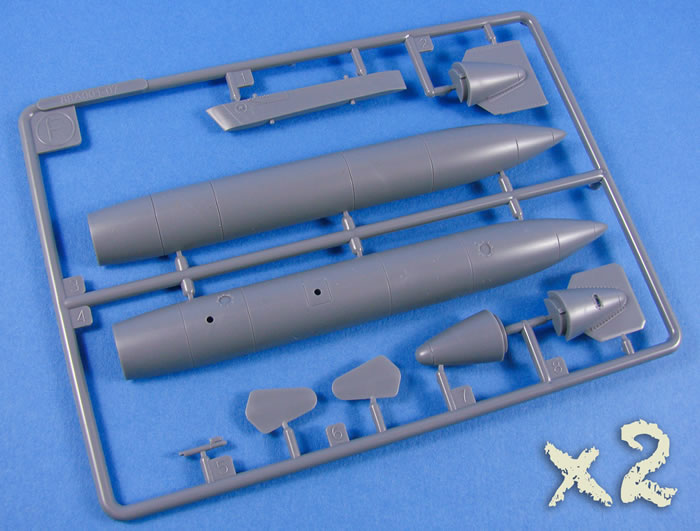
Another small sprue, holding parts for subsonic fuel tank.
SPRUE G & H
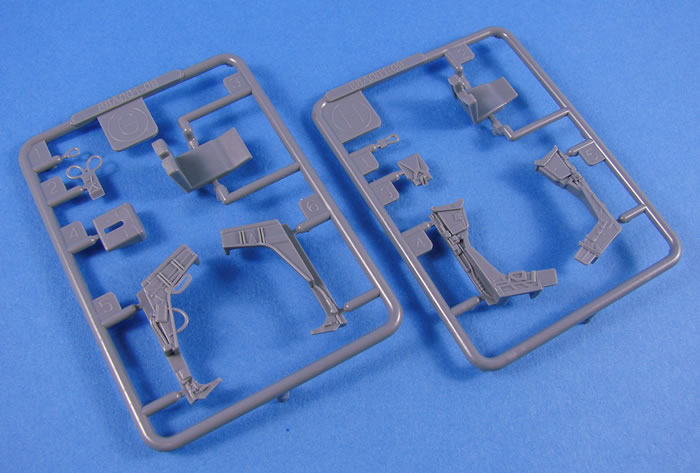
This kit has two seat options. Again, these are for the C2 and C-7. Be warned, these seats are very different in appearance. One niggle is the lack of seatbelts. However, you will find them on that Eduard set that I mentioned. It’s well worth the purchase.
SPRUE J
This clear sprue contains not just the windscreen and hood, but also various lights, HUD screen and also the internal rear-view mirrors.
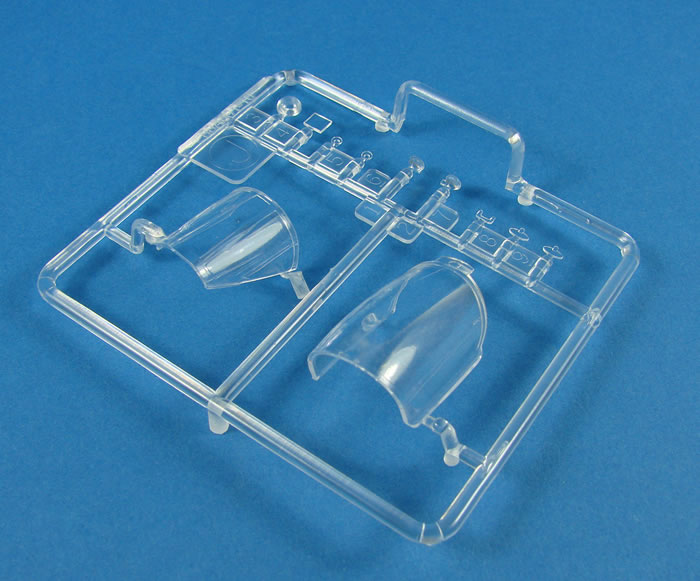
Optically, these are excellent, but there is a small scuff on my hood. That will easily buff out, but it’s annoying.
SPRUE Y
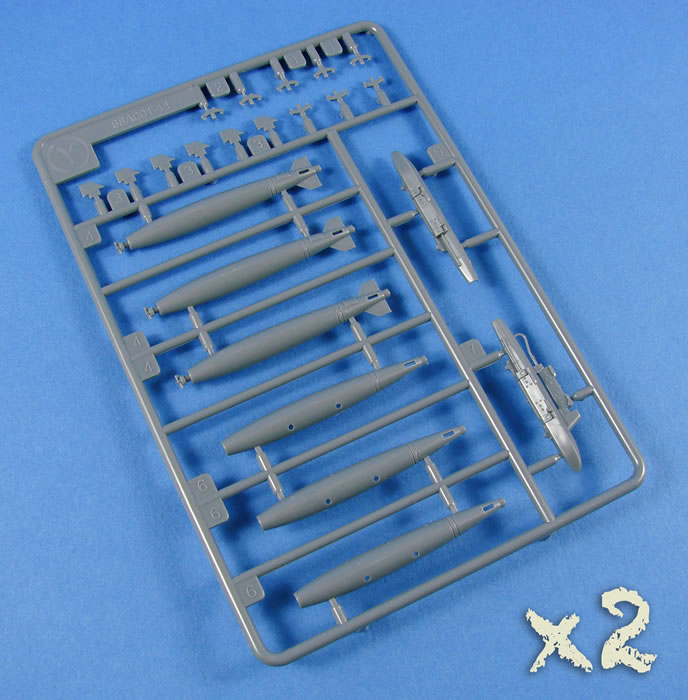
These are the Mk.82 conical fin bombs that fit to the NAPGACH centreline pylon.
A fair few parts are associated with this assembly, but it will look mighty impressive if you choose to fit it.
Weaponry
Here you can see the various weapons that are supplied to loadout and load up your Kfir. These come in the small boxes within the main package, and contain stackable sprues.

Most of these are single-part weapons, or only require minor assembly. Take note that the SAIP-pod has 4 protrusions which are very fragile. This is packaged so that the piggyback sprue protects it.
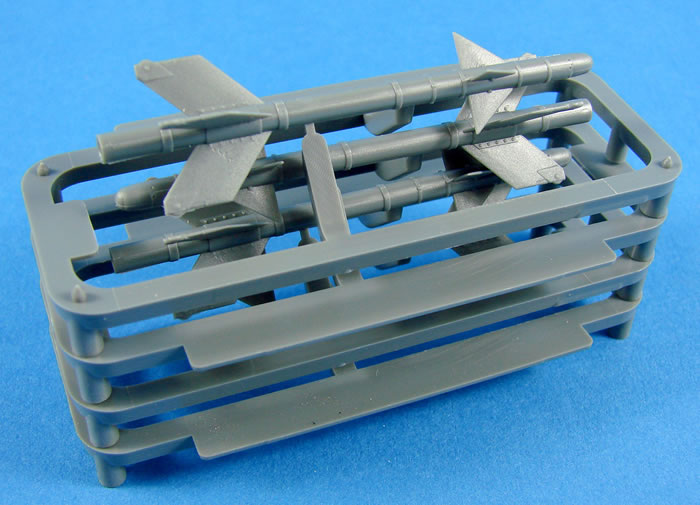
Again, be careful here. Some weapons have slightly bent fins, but no real damage, or certainly nothing that can’t be quickly rectified.
Markings
A single decal sheet is included, and this is pretty packed with stencils, serials, individual aircraft markings and emblems. I can’t vouch for the Hebrew stencils as I simply can’t understand it! Decals are also supplied for the instrument panels, as single pieces. I’d be tempted to dissect this and punch out the instrument gauges, then apply individually. Printing looks very good with things being pretty thin, with solid colour and in register. There are a couple of areas where edges look a little fuzzy though.

The schemes in this release are:
-
Kfir C2, SMF5201, 10th Fighter Squadron, Sri Lanka AF, Katunayake AB, 2011
-
Kfir C7, #543, “Zohar”, The Arava Guardians Squadron, Israeli AF, 1990
-
Kfir C2, NA401AX, ATAC, USA
-
Kfir C2, FAE 905, 2113 Squadron, Ecuadorian AF, 1998
-
Kfir C7, FAC 3043, 111 Squadron, Columbian AF
Instructions
After the introduction history, this manual unusually begins with the five schemes on offer, with a page dedicated to each, clearly showing the paint via FS codes. There is another code, but I can’t relate it to any specific paint brand (*NB, since found this is GSI). I’m sure someone will put me right.
Assembly sequences look pretty easy to follow, with nice, clean line drawings and references to the versions available. Maybe go around with a highlighter first to ensure all the nuances are clear and you don’t fit the wrong option part.
I’m quite partial to these delta-winged fighters, with the Mirage being perhaps the most iconic of them. The Kfir certainly does fit that remit too, with its obvious lines and pedigree being there for all to see. AMK has produced a super little kit of one of Israel’s most successful military ventures.
There are areas where I think Eduard’s magic will pay off, such as the cockpit and seatbelts, but I’m pretty sure this kit could stand on its own with just some handmade belts.
In all, a beautiful little project that appears to capture all the lines of this important fighter, especially with that reworked fuselage and re-tooled weapons! This is a very new kit at the moment, so you might need to ask your hobby retailer to get one in for you.
Highly Recommended.
My sincere thanks to AMK for the review sample
Review Text Copyright © 2018 by James Hatch
Page Created 1 January, 2018
Last updated
1 January, 2018
Back to HyperScale Main Page
Back to Reviews Page

|
